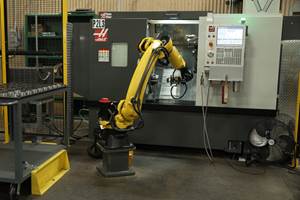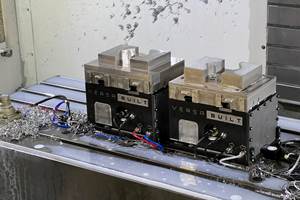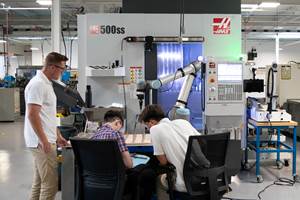3 Machine Options to Aid Automation
Don’t overlook controller options, process security options and coolant handling when staring down the line items of a new machine purchase.
Share






Reader’s Question: We’ve decided on a new automation package to accompany our new machine purchase. As we finalize the order sheet for this machine, what are some other options we should consider to make this entire effort successful?
Miller’s Answer:
In my experience, there are many automation enablers which shops should consider more broadly. Tools such as offline presetters, material prep techniques, CAM, simulation and more can help shops support an automated cell by making the exterior tasks more efficient and reliable. However, simple machine side options can easily go overlooked when staring down the line items of such a massive purchase. There are three main areas where I see shops make mistakes with new automation that make them say, “I wish we bought this.” Those three areas are controller options, process security options and coolant handling.
Controller
The machine’s controller has a few key items which can greatly assist the journey with automation. The first is program storage. The problem is, you may already have probes and toolsetters consuming valuable memory, leaving only a little room for programs. As a stand-alone machine where you process jobs one by one, this may be fine, but likely, as you learn your system and get more comfortable with it, you will eventually want to keep several part programs ready to just call up and run when a repeat order comes in.
In the same spirit, extended tool and work offsets are also handy. If you added a larger magazine to the machine, then the extra tool offsets may seem obvious, but if not, it can be handy to keep a spare tool set around for those repeat orders with their offset already loaded so you can just install the correct tooling and call the right programs and go for the night. The extra work offsets allow for fixed locations to store each different type of workholding you may have coming into the machine and prevent overwriting potentially important work as well. Again, you could reserve a few for those orders you know are coming back and keep a few rotating through the smaller temporary jobs that come through.
Process Security
While the controller storage may be focused on quality of life, I consider the next recommendations to be mandatory for a well-automated machine. In a previous column, I discussed the idea of “process security,” meaning protecting the operator and machine from catastrophe through layered protections. Poka yokes are a common term for some of this, but having a machine equipped to prevent or catch mistakes is important.
Tool life monitoring can capture worn tools before they become broken ones and prompt you to take action during the day for successful night runs. If monitoring fails, then the ability to catch an issue through broken tool detection is a must, as you’d rather the machine stop overnight safely than trash all the tools in the magazine or spindle due to a failed roughing cycle. Lastly, spindle load monitoring can catch the things the other two didn’t catch by stopping the spindle before it is overloaded.
On the workholding side of things, poka yokes are good, but even better is something like a part seat confirmation. This can be accomplished several ways either by air or proximity sensor to make sure parts or even the pallet is where they should be and properly nested against its locating datums on the fixture.
Chip and Coolant Handling
Lastly, we often take for granted how much work an operator does loading each part manually. They often will blow off the fixture, the table and maybe even knock a bird’s nest of chips off the part before loading their next piece. We need to mimic this sequence of events by either preventing it or by asking the robot to do a similar action. A robot can be fitted with a small air knife to help, but when focusing on machine options, I would include coolant and chip handling enhancements.
First, coolant delivery — both volume and direction — is important. Through-spindle coolant, programmable coolant nozzles and extra nozzles for exterior washdown around the edges of the work zone should all be part of the machine if not equipped as standard. To keep all this coolant fresh and limit your required maintenance, you will also want to consider coolant filtration.
To keep things running well through a long day and even seasonally, a coolant chiller can also help and soften the temperature swings we see during long processes. A mist collector will become important to keep more coolant in the machine and improve quality of life at the shop and get rid of the haze of a 24/7 operation. Lastly, a proper lift-up chip conveyor will keep up with the higher chip volume of production.
If the goal of automation is to not be present and to let the spindles make money on their own, then our end goal should be the minimum intervention required to keep the system working well. In a perfect world, you should only need to unload good parts, load in raw material and occasionally add coolant, way lube and grease. Therefore, there are several other options I did not mention here that also work towards the same goal are worth considering.
Do you have a machining question? Ask the expert. John Miller leans on more than a decade of industry experience to answer machining questions from MMS readers. Submit your question online at .
Related Content
Which Approach to Automation Fits Your CNC Machine Tool?
Choosing the right automation to pair with a CNC machine tool cell means weighing various factors, as this fabrication business has learned well.
Read MoreUsing Jaws as Grippers Enables Flexible, Low-Cost Automation
VersaBuilt’s automation systems significantly boosted Innovative Fabrication’s revenue. In return, the shop has helped VersaBuilt optimize its products.
Read MoreCNC Machine Shop Honored for Automation, Machine Monitoring
From cobots to machine monitoring, this Top Shop honoree shows that machining technology is about more than the machine tool.
Read MoreUsing Automation to Reduce COGS and Stay Globally Competitive
Decade-long, multiphase automation investments lower operating costs and maintain technology lead in an increasingly competitive global market.
Read MoreRead Next
AMRs Are Moving Into Manufacturing: 4 Considerations for Implementation
AMRs can provide a flexible, easy-to-use automation platform so long as manufacturers choose a suitable task and prepare their facilities.
Read MoreLast Chance! 2025 Top Shops Benchmarking Survey Still Open Through April 30
Don’t miss out! 91ÊÓƵÍøÕ¾ÎÛ's Top Shops Benchmarking Survey is still open — but not for long. This is your last chance to a receive free, customized benchmarking report that includes actionable feedback across several shopfloor and business metrics.
Read MoreMachine Shop MBA
Making Chips and 91ÊÓƵÍøÕ¾ÎÛ are teaming up for a new podcast series called Machine Shop MBA—designed to help manufacturers measure their success against the industry’s best. Through the lens of the Top Shops benchmarking program, the series explores the KPIs that set high-performing shops apart, from machine utilization and first-pass yield to employee engagement and revenue per employee.
Read More





















